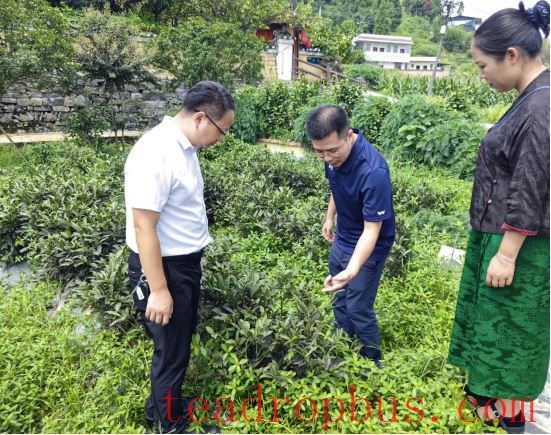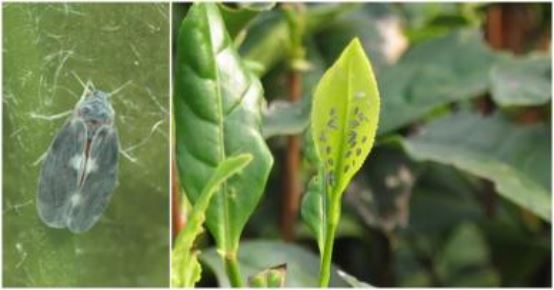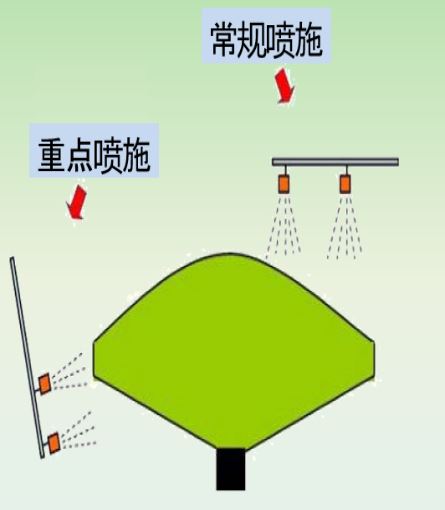Recently, during a field survey in the Xiangxi Tea region, Deputy Researcher Luo Zongxiu, a member of Dr. Cai Xiaoming's team from the National Tea Industry Technical System's Pest and Weed Research Laboratory, along with Xiangxi Station Director Peng Yun, found a tea garden severely affected by the black scale mealybug. The experts carefully observed the situation and, considering the differences in terrain and environment as well as the severity of the pest infestation, Deputy Researcher Luo proposed specific control measures.

Deputy Researcher Luo Zongxiu (center) and Director Peng Yun (left) observing and guiding in the field
I. Incidence Pattern
The tea black scale mealybug (Aleurocanthus camelliae Kanmiya & Kasai) belongs to the Hemiptera order, Aleurodidae family, and is a common pest in tea gardens. It has four generations each year, overwintering as older nymphs on the underside of leaves. The overwintering adults emerge in large numbers in late April. The first generation of larvae appears in mid-May, and the peak periods for the 1st, 2nd, and 3rd generations of larvae are respectively in late May, late July, and late August. The first generation is more uniform, while overlapping generations become increasingly apparent after the second. Adults are more active during the day and prefer to rest on the underside of new shoots and young leaves in the morning and evening. Eggs are laid on the underside of leaves, mainly on those in the middle and lower parts of the plant and near the fish leaves. Newly hatched larvae settle nearby on the underside of the leaf and feed until they pupate and emerge as adults. In addition to damaging the leaves, their excretions can induce sooty mold disease, weakening photosynthesis and halting new shoot growth, which significantly affects both yield and quality.

Adult tea black scale mealybug
The incidence of black scale mealybugs is closely related to tea garden density, the number of intercropped plants, and tree vigor. They are more prevalent in densely planted gardens compared to conventional ones. Intercropping and low-lying gardens with poor ventilation and light transmission, as well as those with a microclimate that is warm and humid, are more prone to infestations.

Symptoms of sooty mold disease induced by black scale mealybug excretions
II. Control Methods
1. Physical and Chemical Luring Control
In late April, during the peak emergence of overwintering adults, yellow sticky boards are hung in open-air tea gardens to trap adult black scale mealybugs. Use 300-400 sticky boards per hectare, suspended 10-15 cm above the tea canopy.
2. Biological Formulations Control
In organic tea gardens, use botanical extracts such as matrine, pyrethrum, and Webera spore powder for control. Follow the dosage and application instructions provided with the product.
3. Natural Enemy Control
There are many natural enemies of black scale mealybugs, including predatory species like spiders, ladybirds, and lacewings, and parasitic species like Aphytis melinus, Aphytis lingnanensis, Chrysoperla sinica, and Tetrastichus longiculus. Protect local natural enemy resources in tea gardens and consider releasing beneficial insects like lacewings and ladybirds to control black scale mealybugs.
4. Chemical Control
The control threshold for small-leaved tea varieties is 2-3 individuals per leaf, and for large-leaved varieties, it is 4-7 individuals per leaf. The key times and targets for control are the peak periods of eggs and 1st instar nymphs, with a focus on the 1st and 4th generations and selective treatments for the 2nd and 3rd generations. When the threshold is exceeded, chemical control should be considered. Recommended sprays include 15% buprofezin at 2000-3000 times dilution (equivalent to 28-40 mL per mu, with a safe interval of 10 days) or 10% bifenthrin at 5000 times dilution (equivalent to 16 mL per mu, with a safe interval of 7 days).
Note: The following pesticides are prohibited or recommended for discontinuation in tea gardens: imidacloprid, acetamiprid, fenvalerate (phynolinate), triclofan, methyl cyfluthrin (lambda-cyhalothrin), methyl parathion, pyriproxyfen (buprofezin, thiocyclone, unilad), dicofol (dicofol), and diazinon.

Illustration of pesticide application techniques for tea black scale mealybug